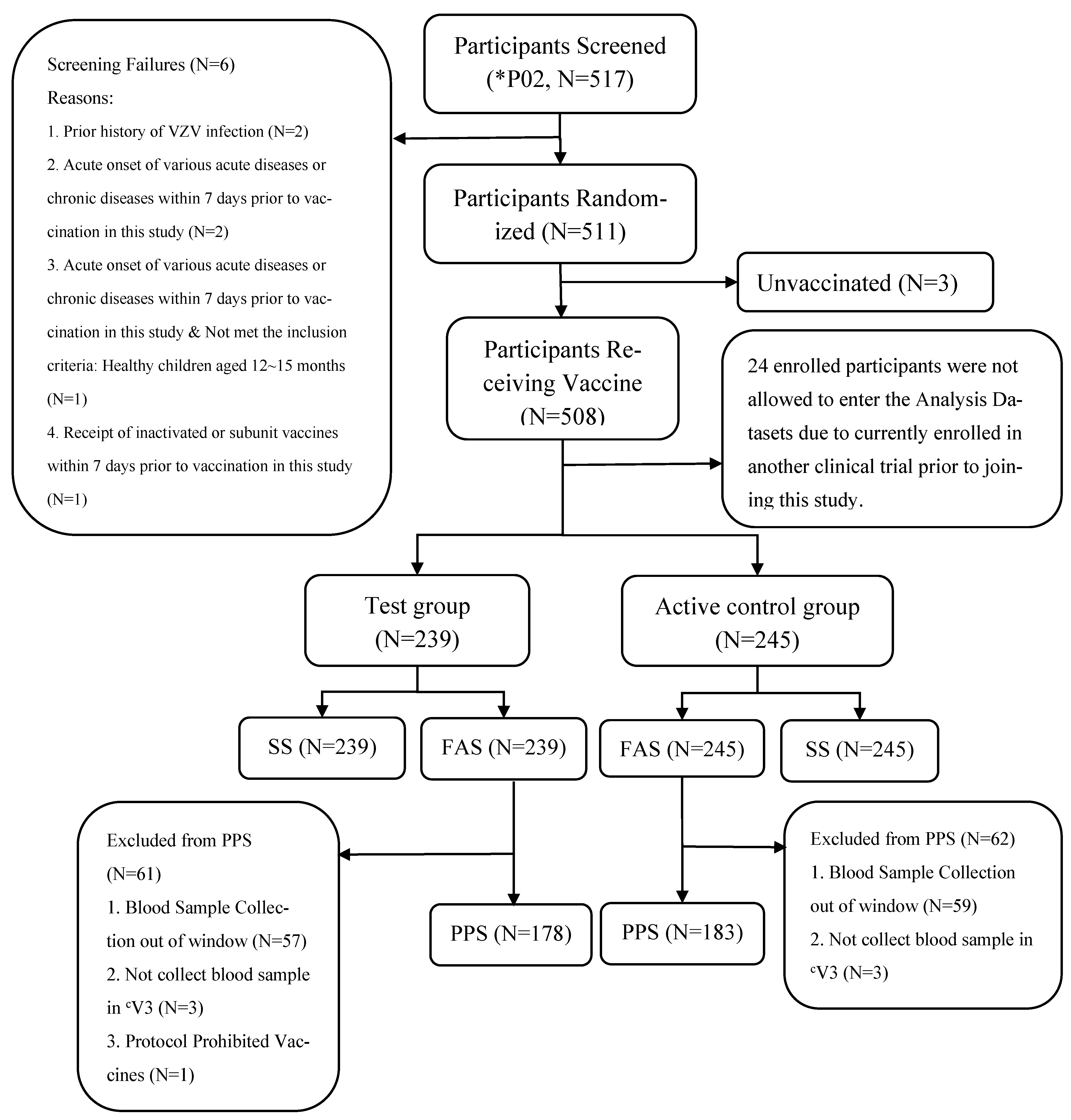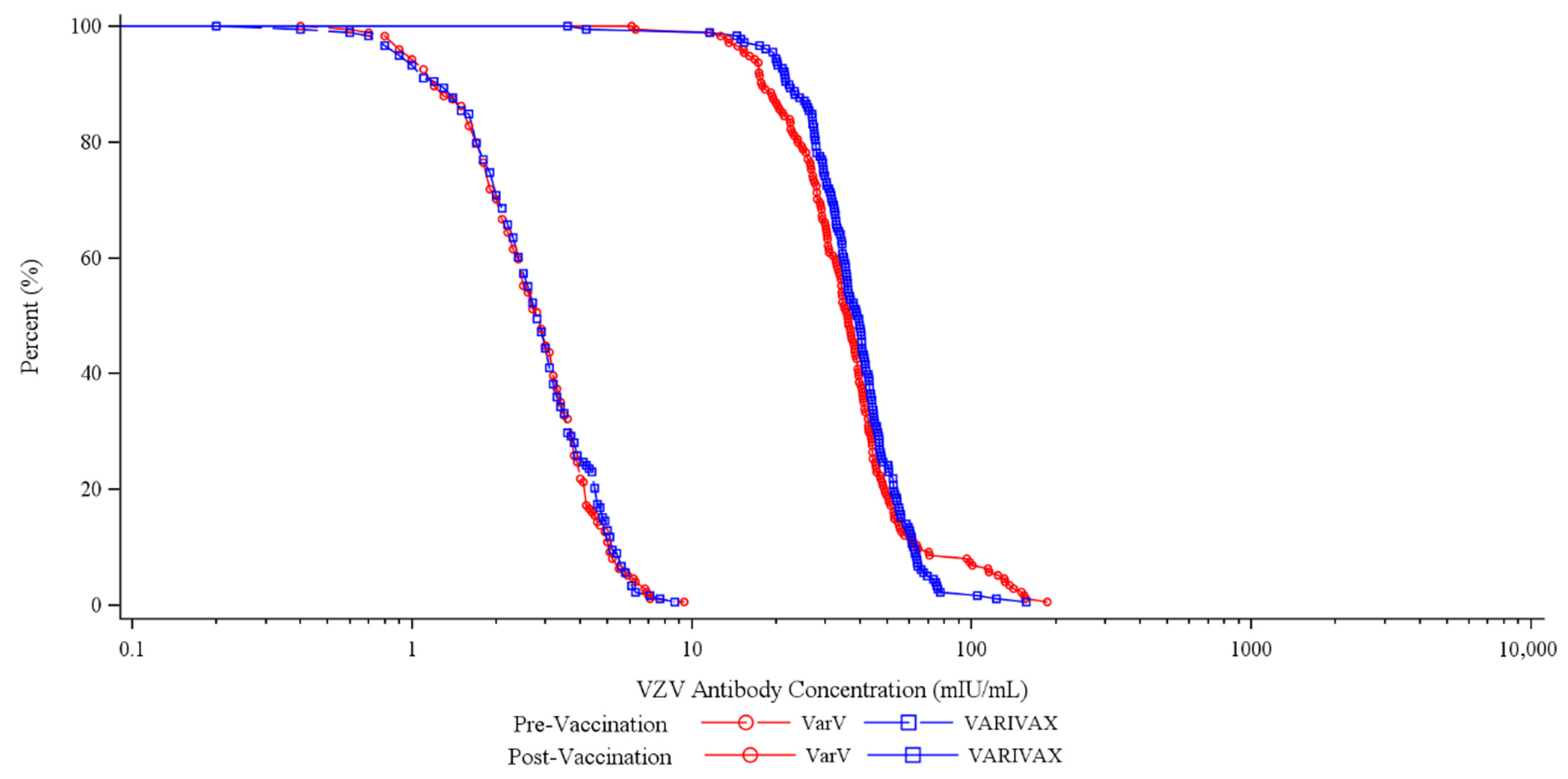Immunogenicity and Safety of a Live Attenuated Varicella Vaccine in Healthy Children Aged 12 to 15 Months: A Phase III, Randomized, Double-Blind, Active-Controlled Clinical Trial
Abstract
1. Background
2. Methods
2.1. Study Design
2.2. Study Population
2.3. Vaccines
2.4. Immunogenicity Assessment
2.5. Safety Assessment
2.6. Randomization and Masking
2.7. Sample Size Determination
2.8. Statistical Analysis
3. Results
3.1. Participants Included in the Study
3.2. Immunogenicity Results
3.3. Safety Results
4. Discussion
5. Conclusions
Author Contributions
Funding
Institutional Review Board Statement
Informed Consent Statement
Data Availability Statement
Acknowledgments
Conflicts of Interest
References
- Van Staveren, M. Integrating Python into a Physical Chemistry Lab. J. Chem. Educ. 2022, 99, 2604–2609. [Google Scholar] [CrossRef]
- Sun, D.; Yu, D.; Du, Z.; Jia, N.; Liu, X.; Sun, J.; Xu, Q.; Sun, Z.; Luan, C.; Lv, J.; et al. Immunogenicity and safety of a live attenuated varicella vaccine co-administered with inactive hepatitis A vaccine: A phase 4, single-center, randomized, controlled trial. Hum. Vaccin. Immunother. 2023, 19, 2161789. [Google Scholar] [CrossRef] [PubMed]
- Chiu, S.S.; Lau, Y.-L. Review of the Varilrix™ varicella vaccine. Expert. Rev. Vaccines 2005, 4, 629–643. [Google Scholar] [CrossRef]
- Harder, T.; Siedler, A. Systematic Review and Meta-analysis of Chickenpox Vaccination and Risk of Herpes Zoster: A Quantitative View on the “Exogenous Boosting Hypothesis”. Clin. Infect. Dis. 2018, 69, 1329–1338. [Google Scholar] [CrossRef] [PubMed]
- Gershon, A.A.; Breuer, J.; Cohen, J.I.; Cohrs, R.J.; Gershon, M.D.; Gilden, D.; Grose, C.; Hambleton, S.; Kennedy, P.G.; Oxman, M.N.; et al. Varicella zoster virus infection. Nat. Rev. Dis. Primers 2015, 1, 15016. [Google Scholar] [CrossRef] [PubMed]
- Takahashi, M.; Asano, Y.; Kamiya, H.; Baba, K.; Ozaki, T.; Otsuka, T.; Yamanishi, K. Development of Varicella Vaccine. J. Infect. Dis. 2008, 197, S41–S44. [Google Scholar] [CrossRef]
- Vázquez, M.; LaRussa, P.S.; Gershon, A.A.; Steinberg, S.P.; Freudigman, K.; Shapiro, E.D. The Effectiveness of the Varicella Vaccine in Clinical Practice. N. Engl. J. Med. 2001, 344, 955–960. [Google Scholar] [CrossRef]
- Duan, C.; Zhang, Y.; Zhang, Q.; Zhang, S.; Zhong, P.; Gong, G.; Zhu, Y.; Fei, J.; Zhao, J.; Sun, Y.; et al. Impact of natural and socio-economic factors on varicella incidence in children in Shanghai, 2013–2022. Front. Public Health 2025, 13, 1565717. [Google Scholar] [CrossRef]
- Huang, L.; Chen, Z.; Song, Y.; Tan, J.; Jia, N.; You, W.; Yuan, H.; Feng, G.; Li, C.; Luan, C.; et al. Immunogenicity and safety of a live-attenuated varicella vaccine in a healthy population aged 13 years and older: A randomized, double-blind, controlled study. Vaccine 2024, 42, 396–401. [Google Scholar] [CrossRef]
- Zhang, Y.; Wang, L.; Wang, Y.; Zhang, W.; Jia, N.; Xie, Z.; Huang, L.; You, W.; Lu, W.; Li, E.; et al. Immunogenicity and Safety of a Booster Dose of Live Attenuated Varicella Vaccine, and Immune Persistence of a Primary Dose for Children Aged 2 to 6 Years. Vaccines 2022, 10, 660. [Google Scholar] [CrossRef]
- Wang, B.; Li, T.; Meng, F.; Tang, J.; Luo, X.; Xu, H.; Cheng, Y.; Qin, W.; Wu, H.; Ge, K.; et al. Adverse reactions following vaccination with varicella attenuated livevaccine among healthy children aged 1-12 years: An observationalstudy in areas of Anhui province. Chin. J. Vaccines Immun. 2024, 30, 461–465. [Google Scholar]
- Marin, M.; Marti, M.; Kambhampati, A.; Jeram, S.M.; Seward, J.F. Global Varicella Vaccine Effectiveness: A Meta-analysis. Pediatrics 2016, 137, e20153741. [Google Scholar] [CrossRef]
- Lau, Y.-L.; Rupert Vessey, S.J.; Chan, I.S.F.; Lee, T.-L.; Huang, L.-M.; Lee, C.-Y.; Lin, T.-Y.; Lee, B.W.; Kwan, K.; Kasim, S.M.; et al. A comparison of safety, tolerability and immunogenicity of Oka/Merck varicella vaccine and VARILRIX™ in healthy children. Vaccine 2002, 20, 2942–2949. [Google Scholar] [CrossRef]
- Wu, Q.; Rivailler, P.; Xu, S.; Xu, W. Comparison of the Whole-Genome Sequence of an Oka Varicella Vaccine from China with Other Oka Vaccine Strains Reveals Sites Putatively Critical for Vaccine Efficacy. J. Virol. 2019, 93, e02281-18. [Google Scholar] [CrossRef]
- Schmid, D.S.; Jumaan, A.O. Impact of Varicella Vaccine on Varicella-Zoster Virus Dynamics. Clin. Microbiol. Rev. 2010, 23, 202–217. [Google Scholar] [CrossRef] [PubMed]
- Umit, Z.; Sahbudak Bal, Z.; Zeytinoglu, A.; Aydogan, T.G.; Bag, O.; Ozenen, G.G.; Ozkinay, F.; Kurugol, Z. The comparison of seroconversion rates among different varicella vaccines administered Turkish children; MAV/06 and vOka. Hum. Vaccin. Immunother. 2021, 17, 4190–4193. [Google Scholar] [CrossRef] [PubMed]
- Klein, E.Y.; Van Boeckel, T.P.; Martinez, E.M.; Pant, S.; Gandra, S.; Levin, S.A.; Goossens, H.; Narayan, R.L. Global increase and geographic convergence in antibiotic consumption between 2000 and 2015. Proc. Natl. Acad. Sci. USA 2018, 115, 3463–3470. [Google Scholar] [CrossRef] [PubMed]
- Jiang, F.; Zhang, R.; Guan, Q.; Mu, Q.; He, P.; Ye, X.; Wang, W.; Quan, J.; Li, J.; Liang, L.; et al. Immunogenicity and safety of a live attenuated varicella vaccine in children 1–12 years of age: A randomized, blinded, controlled, non-inferiority phase 3 clinical trial. Contemp. Clin. Trials 2021, 107, 106489. [Google Scholar] [CrossRef]
- Huang, L.; Chen, Z.; Hu, Y.; Xie, Z.; Qiu, P.; Zhu, L.; Bao, M.; Quan, Y.; Zeng, J.; Wang, Y.; et al. Safety, immunogenicity, and lot-to-lot consistency of live attenuated varicella vaccine in 1-3 years old children: A double-blind, randomized phase III trial. Hum. Vaccin. Immunother. 2019, 15, 822–827. [Google Scholar] [CrossRef]
- Miettinen, O.; Nurminen, M. Comparative analysis of two rates. Stat. Med. 1985, 4, 213–226. [Google Scholar] [CrossRef]
- Prymula, R.; Simko, R.; Povey, M.; Kulcsar, A. Varicella vaccine without human serum albumin versus licensed varicella vaccine in children during the second year of life: A randomized, double-blind, non-inferiority trial. BMC Pediatr. 2016, 16, 7. [Google Scholar] [CrossRef] [PubMed][Green Version]
- Choi, U.Y.; Kim, K.H.; Cho, H.K.; Kim, D.H.; Ma, S.H.; Choi, Y.Y.; Kim, C.S.; Capeding, M.R.; Kobashi, I.A.R.; Kim, H.; et al. Immunogenicity and Safety of a Newly Developed Live Attenuated Varicella Vaccine in Healthy Children: A Multi-National, Randomized, Double-Blinded, Active-Controlled, Phase 3 Study. Vaccines 2023, 11, 1416. [Google Scholar] [CrossRef]
- Choi, U.Y.; Kim, K.H.; Lee, J.; Eun, B.W.; Kim, D.H.; Ma, S.H.; Kim, C.S.; Lapphra, K.; Tangsathapornpong, A.; Kosalaraksa, P.; et al. Immunogenicity and safety profiles of a new MAV/06 strain varicella vaccine in healthy children: A multinational, multicenter, randomized, double-blinded, active-controlled phase III study. Vaccine 2021, 39, 1758–1764. [Google Scholar] [CrossRef]
- WHO SAGE Working Group on Varicella and Herpes Zoster Vaccines. Systematic Review of Effectiveness and Duration of Protection of Varicella Vaccines; World Health Organization: Geneva, Switzerland, 2014. [Google Scholar]
- World Health Organization. Varicella and herpes zoster vaccines: WHO position paper. Wkly. Epidemiol. Rec. 2014, 89, 265–288. [Google Scholar]
- Kuter, B.; Matthews, H.; Shinefield, H.; Black, S.; Dennehy, P.; Watson, B.; Reisinger, K.; Kim, L.L.; Lupinacci, L.; Hartzel, J.; et al. Ten year follow-up of healthy children who received one or two injections of varicella vaccine. Pediatr. Infect. Dis. J. 2004, 23, 132–137. [Google Scholar] [CrossRef] [PubMed]
- World Health Organization. Meeting of the Strategic Advisory Group of Experts on Immunization, April 2014: Conclusions and recommendations. Wkly. Epidemiol. Rec. 2014, 89, 221–236. [Google Scholar]


| Indicator | Test Group | Active Control Group | p Value |
|---|---|---|---|
| No. | 239 | 245 | |
| Age (Months), Mean ± SD | 13.2 ± 1.064 | 13.1 ± 1.015 | 0.2044 |
| Gender | 0.7048 | ||
| Male, n (%) | 128 (53.56) | 127 (51.84) | |
| Female, n (%) | 111 (46.44) | 118 (48.16) | |
| Race | 1.0000 | ||
| Asian, n (%) | 239 (100.00) | 244 (99.59) | |
| White, n (%) | 0 (0.00) | 1 (0.41) | |
| Height(cm), Mean ± SD | 73.71 ± 2.973 | 73.95 ± 3.399 | 0.4087 |
| Weight(kg), Mean ± SD | 8.82 ± 1.240 | 8.92 ± 1.288 | 0.3956 |
| Indicator | Test Group (N = 175) | Active Control Group (N = 178) | * Difference/Ratio (95%CI) | p Value |
|---|---|---|---|---|
| Pre-vaccination | ||||
| GMC | 2.56 | 2.57 | 0.9509 | |
| (95% CI) | (2.35, 2.78) | (2.35, 2.80) | ||
| Post-vaccination | ||||
| Seroresponse rate, (%) | 98.85 | 98.88 | −0.03 | 1.0000 |
| (95% CI) | (95.91, 99.86) | (96.00, 99.86) | (−3.10, 2.99) | |
| GMC | 35.73 | 37.34 | 0.96 | 0.4103 |
| (95% CI) | (33.15, 38.51) | (34.68, 40.21) | (0.86, 1.06) | |
| GMFR | 13.96 | 14.55 | 0.5786 | |
| (95% CI) | (12.56, 15.52) | (13.16, 16.07) |
| Test Group (N = 239) | Active Control Group (N = 245) | p Value | |||
|---|---|---|---|---|---|
| ARs | No. of Events | No. of Participants (%) | No. of Events | No. of Participants (%) | |
| Overall | 170 | 91 (38.08) | 253 | 136 (55.51) | 0.0001 |
| Grade 3 | 4 | 4 (1.67) | 11 | 5 (2.04) | 1.0000 |
| Solicited | 157 | 89 (37.24) | 238 | 136 (55.51) | <0.0001 |
| Local | |||||
| Pain | 17 | 17 (7.11) | 26 | 26 (10.61) | 0.2024 |
| Induration | 2 | 2 (0.84) | 1 | 1 (0.41) | 0.6196 |
| Swelling | 2 | 2 (0.84) | 7 | 7 (2.86) | 0.1759 |
| Erythema | 36 | 36 (15.06) | 99 | 99 (40.41) | <0.0001 |
| Rash | 0 | 0 (0.00) | 1 | 1 (0.41) | 1.0000 |
| Pruritus | 2 | 2 (0.84) | 1 | 1 (0.41) | 0.6196 |
| Systemic | |||||
| Pyrexia | 40 | 37 (15.48) | 51 | 45 (18.37) | 0.4673 |
| Hypersensitivity | 1 | 1 (0.42) | 0 | 0 (0.00) | 0.4938 |
| Diarrhea | 21 | 20 (8.37) | 18 | 17 (6.94) | 0.6098 |
| Nausea | 5 | 5 (2.09) | 4 | 4 (1.63) | 0.7489 |
| Vomiting | 10 | 10 (4.18) | 10 | 9 (3.67) | 0.8184 |
| Cough | 21 | 19 (7.95) | 21 | 18 (7.35) | 0.8650 |
| Unsolicited | 13 | 11 (4.60) | 15 | 13 (5.31) | 0.8350 |
Disclaimer/Publisher’s Note: The statements, opinions and data contained in all publications are solely those of the individual author(s) and contributor(s) and not of MDPI and/or the editor(s). MDPI and/or the editor(s) disclaim responsibility for any injury to people or property resulting from any ideas, methods, instructions or products referred to in the content. |
© 2025 by the authors. Licensee MDPI, Basel, Switzerland. This article is an open access article distributed under the terms and conditions of the Creative Commons Attribution (CC BY) license (https://creativecommons.org/licenses/by/4.0/).
Share and Cite
Nazaire-Bermal, N.; Jia, N.; Maronilla, M.A.C.; Lopez, J.F.; Zeng, G.; Wu, W.; Nimo, A.B.C.; Luan, C.; Xin, Q. Immunogenicity and Safety of a Live Attenuated Varicella Vaccine in Healthy Children Aged 12 to 15 Months: A Phase III, Randomized, Double-Blind, Active-Controlled Clinical Trial. Vaccines 2025, 13, 973. https://doi.org/10.3390/vaccines13090973
Nazaire-Bermal N, Jia N, Maronilla MAC, Lopez JF, Zeng G, Wu W, Nimo ABC, Luan C, Xin Q. Immunogenicity and Safety of a Live Attenuated Varicella Vaccine in Healthy Children Aged 12 to 15 Months: A Phase III, Randomized, Double-Blind, Active-Controlled Clinical Trial. Vaccines. 2025; 13(9):973. https://doi.org/10.3390/vaccines13090973
Chicago/Turabian StyleNazaire-Bermal, Nancy, Ningning Jia, Maria Angela C. Maronilla, Josemaria F. Lopez, Gang Zeng, Wenbin Wu, Adrielle Bernice C. Nimo, Chunfang Luan, and Qianqian Xin. 2025. "Immunogenicity and Safety of a Live Attenuated Varicella Vaccine in Healthy Children Aged 12 to 15 Months: A Phase III, Randomized, Double-Blind, Active-Controlled Clinical Trial" Vaccines 13, no. 9: 973. https://doi.org/10.3390/vaccines13090973
APA StyleNazaire-Bermal, N., Jia, N., Maronilla, M. A. C., Lopez, J. F., Zeng, G., Wu, W., Nimo, A. B. C., Luan, C., & Xin, Q. (2025). Immunogenicity and Safety of a Live Attenuated Varicella Vaccine in Healthy Children Aged 12 to 15 Months: A Phase III, Randomized, Double-Blind, Active-Controlled Clinical Trial. Vaccines, 13(9), 973. https://doi.org/10.3390/vaccines13090973





